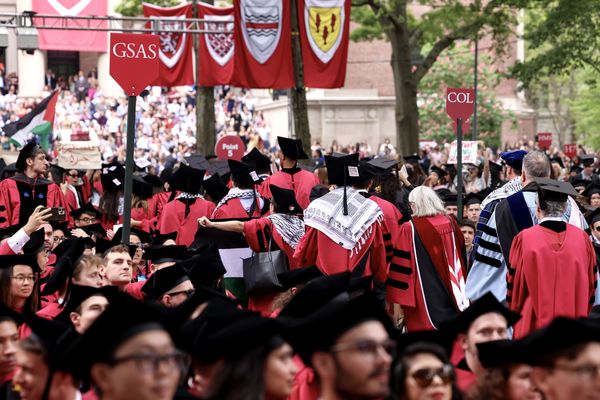Tom Webber is one of the lucky ones. The talented 24-year-old singer-songwriter has a record deal, a management team and a publishing contract. He has played at Glastonbury, has supported Suzanne Vega and his tracks have been streamed hundreds of thousands of times on Spotify. But Webber still lives at home with his parents in Didcot and travels into London to perform. “I don’t make any money,” he says with admirable frankness.
Webber knows how fortunate he is to have made it onto the first rung of the music industry ladder. But life is tough, with the cost of performing rising and small venues closing. “It's a lot harder than I'm sure it probably was. I'm only 24 but it's hard because there are fewer and fewer grassroots venues, and I think things like Covid probably didn't help,” he says. Over the three years that he’s been playing music professionally he’s seen fellow musicians “dropping like flies”.
Tom Kiehl, the chief executive of UK Music which represents Britain’s music industry, says things are brutal out there. “It’s incredibly tough for emerging artists trying to break through in London right now,” Kiehl tells me. “They face a cocktail of challenges that pose a serious threat to the capital’s music scene.”
London has seen more than 50 small venues close since 2013, according to the Music Venue Trust (MVT), which represents grassroots venues. Casualties include Soho’s Borderline, Holloway Road’s Nambucca and Brixton’s Club 414. Today it is “immeasurably harder” for musicians to make a living than it was a decade ago, says Mark Davyd, the MVT’s founder and chief executive. And what’s killing London’s creativity is “unfortunately not just one thing”.
Although venues might be full, the costs of staff, rates, rent and utilities often rise faster than the venues’ ticket, food and drink receipts. Venues’ average rents rose by 37 per cent in 2023 alone, and “you can’t increase the price of beer by 37 per cent”, Davyd says.

Conversely, some venues struggle to afford artists because artists’ costs have also soared. Last month’s Budget made things worse. The hike in employers’ National Insurance means it is more expensive to hire venue staff, and grassroots venues’ business rate relief will be cut from 70 to 40 per cent next April, costing them £7 million. This puts 350 more venues at risk nationwide, which would mean 75,000 fewer gigs annually, says the MVT.
These “huge, unmanageable” increases in costs are happening just as consumers find their own budgets being squeezed, says Davyd. London is the world’s eighth most expensive city to live in, according to a June survey by consulting firm Mercer. As one viral post on X recently put it, four pints and a packet of cigarettes cost £50 these days. No wonder young artists can’t afford to live here.
Then there’s the displacement theory. When a ticket to see Oasis can cost hundreds of pounds, music fans have less money to spend on smaller concerts. “The rise in costs for large-scale events is leaving people with less disposable income to spend on smaller gigs, resulting in less exposure and fewer opportunities for new musicians,” says Michael Kill, chief executive of the Night Time Industries Association.
Add an expensive transport network and changing behaviours to this depressing melange – Gen Z-ers are drinking less in a sector of the economy supported by the sale of alcohol – and there’s only one reasonable conclusion: who’d be a musician in London these days? Creativity in the capital is in danger of being decimated.
These ‘huge, unmanageable’ increases in costs are happening just as consumers find their own budgets being squeezed
But it’s not just external factors that are affecting artists. Changes to how record labels do things are also having consequences, some argue. “Labels don’t take any risks anymore,” is the blunt assessment of one industry insider.
One problem is that A&R – or talent-scouting – has changed over the last decade, according industry veteran Nick Stewart, who signed U2 and happens to own Breaking Wave, the independent label to which Webber is signed. “When I was first an A&R man, the pack went out looking in pubs and clubs almost every night for next big thing,” says Stewart. But in recent times, many pop acts have attracted record label attention based on social media hits and streaming numbers. “Now lots of pop acts are signed off TikTok or Instagram,” Stewart says. However there are indications that “the old-fashioned way is coming back”.
Louis Bloom is the boss of Island Records and EMI, both owned by the world’s biggest music group Universal. He lists artists that his label has recently signed through old-fashioned A&R in London venues: The Last Dinner Party (who had strong links to the scene around Brixton’s Windmill venue), English Teacher (from Leeds but were playing at the now-closed House of Vans in Waterloo when signed – they’ve since won the Mercury Prize), girl band Flo (now touring the world), Lola Young (she was playing The Bedford in Balham, and now features on Tyler, The Creator’s new album) and jungle artist Nia Archives (who was playing small venues in Bethnal Green and is now playing Brixton Academy).

How artists are discovered might have changed – demo cassettes don’t exist anymore and, yes, data can play a role – but Bloom says that “the gig element is still the most important bit to see if someone’s the real deal”.
Bloom concedes that his labels are probably signing slightly fewer acts than before, but he says venues remain the music scene’s lifeblood. “We have to keep the venues working and nurturing these smaller acts. It’s essential for the ecosystem [and] to get artists who will compete on the world stage in the unique and eccentric way that the Brits have always done,” he says.
Still, the cost of putting on a show can be prohibitive. Davyd compares the world today to when he promoted his first concert 40 years ago. “I hired the venue, the PA system, the security, the lighting crew – everything. I paid the headline band a good fee and I paid support bands, and I made money and paid myself. That was a 400 capacity gig. If you did that now you’d go bankrupt,” he says. For Webber, touring today is about “keeping costs as minimum as possible”, such as by splitting the outlay with another musician. He’d love a full backing band but “all of that costs money”.
There is hope, though. Last year was the best year ever for live music attendance and income, says Davyd, even if most of it was concentrated at the top end – the Taylor Swift end, if you will – of the concert spectrum.
But Island’s Bloom believes things are now starting to fizz at the bottom end too. “I am seeing an emergence of people wanting to go back into the real world and be around fellow music-lovers,” he says. “There are communities developing – for instance at the George Tavern in Whitechapel – and I think the demand is coming back on a local venue level.” That’s if venues survive long enough to remain open.







